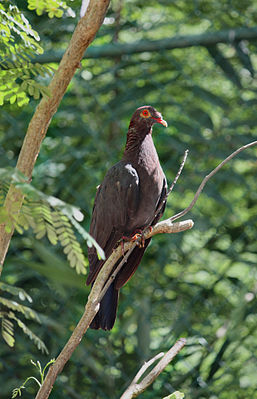Antilles pigeon
| Antilles pigeon | ||||||||||
|---|---|---|---|---|---|---|---|---|---|---|

Patagioenas squamosa , Christ Church, Barbados . |
||||||||||
| Systematics | ||||||||||
|
||||||||||
| Scientific name | ||||||||||
| Patagioenas squamosa | ||||||||||
| ( Bonnaterre , 1792) |
The Antilles pigeon ( Patagioenas squamosa ), also known as the red-necked pigeon or portorico pigeon , is a species of pigeon birds. It occurs exclusively in the Caribbean.
Appearance
The Antilles pigeon reaches a body length of up to 41 centimeters. It is a relatively large pigeon. There is no gender dimorphism.
The body plumage of the Antilles pigeon is a dark slate gray. The head and chest are somewhat lighter than the rest of the body's plumage and have a wine-red sheen. The feathers on the sides of the neck and nape are burgundy with dark hems. The nape and throat side plumage looks clearly scaled. The beak is reddish at the base and brightens towards the tip. The feet are dark red. Antillean pigeons have noticeable dark circles that vary from orange to bright red.
distribution and habitat
The Antilles pigeon occurs in the Greater Antilles with the exception of Jamaica , the Virgin Islands and the Lesser Antilles . It is a locally common species that occurs mainly in primary forest. However, it is heavily hunted in some parts of its range and is at risk of regional extermination. Habitat changes and the conversion of forests into agricultural areas also affect the stock. For example, it was last seen in Aruba in 1973.
The Antillean pigeon prefers the mountain and highlands as well as plantations. It is observed only relatively rarely in the flat coastal areas.
Way of life
The Antillean pigeon is a relatively shy pigeon whose way of life is tied to trees. It only comes to the ground relatively seldom to pick up seeds. Their food spectrum includes a wide range of fruits, berries and seeds. It also eats buds and leaves, as well as small snails. The Antilles pigeon is predominantly a resident bird. Migrations can occur due to food availability.
The breeding time is not seasonal, but is influenced by the availability of food. Nests are found all year round. The nest is built in a tree or shrub and its loose design is similar to that of most other pigeon birds. The clutch consists of an egg. A breeding time of 13 days has been observed several times in the Antilles pigeon kept in human care. This is an unusually short breeding season for American field pigeons . Breeders of this species have already pointed out breeding times of 17 to 18 days. The young birds fledge after 21 to 23 days.
Keeping in human care
The Antilles pigeon was first shown at London Zoo in 1868. The first breeding took place there in 1876. In Germany, the Antillean pigeon was kept by several breeders in the early 1980s. The birds came from the Netherlands, where they were bred very successfully. The species is considered scary and needs a very large, well-planted aviary for species-appropriate keeping.
supporting documents
Individual evidence
literature
- David Gibbs, Eustace Barnes and John Cox: Pigeons and Doves - A Guide to the Pigeons and Doves of the World . Pica Press, Sussex 2001, ISBN 90-74345-26-3
- Alois Münst and Josef Wolters: Tauben - The types of wild pigeons , 2nd expanded and revised edition, Verlag Karin Wolters, Bottrop 1999, ISBN 3-9801504-9-6
- Gerhard Rösler: The wild pigeons of the earth - free living, keeping and breeding . M. & H. Schaper Verlag, Alfeld-Hannover 1996, ISBN 3-7944-0184-0
Web link
- Patagioenas squamosa inthe IUCN 2013 Red List of Threatened Species . Listed by: BirdLife International, 2012. Retrieved October 12, 2013.

